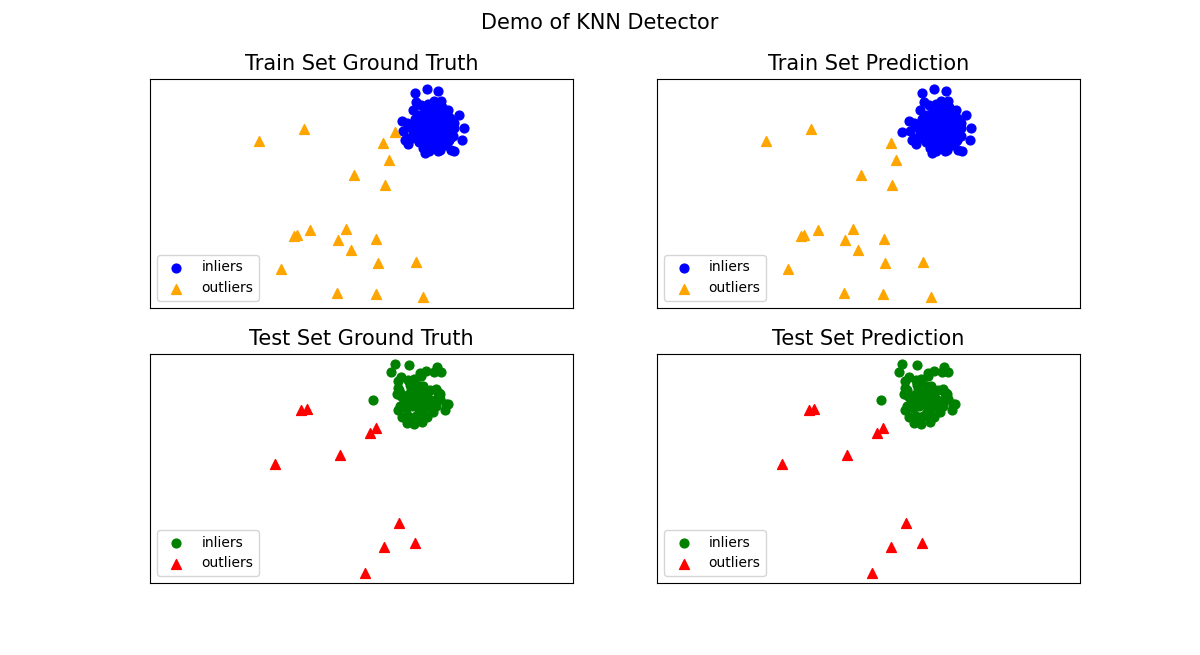Examples
Featured Tutorials
PyThresh has a variety of different thresholding methods and an online example can be found at.
Towards Data Science: Thresholding Outlier Detection Scores with PyThresh
Karcher Mean Example
Full example: karch_example.py
Import models
from pyod.models.knn import KNN from pyod.utils.data import generate_data from pyod.utils.data import evaluate_print from pyod.utils.example import visualize from pythresh.thresholds.karch import KARCH
Generate sample data with
pyod.utils.data.generate_data():contamination = 0.1 # percentage of outliers n_train = 200 # number of training points n_test = 100 # number of testing points X_train, X_test, y_train, y_test = generate_data( n_train=n_train, n_test=n_test, n_features=2, contamination=contamination, random_state=42, )
3. Initialize a pyod.models.knn.KNN detector, fit the model,
and threshold the outlier detection scores.
# train kNN detector clf_name = "KNN" clf = KNN() clf.fit(X_train) thres = KARCH() # get the prediction labels and outlier scores of the training data y_train_scores = clf.decision_scores_ # raw outlier scores y_train_pred = thres.eval(y_train_scores) # binary labels (0: inliers, 1: outliers) # get the prediction on the test data y_test_scores = clf.decision_function(X_test) # outlier scores y_test_pred = thres.eval(y_test_scores) # outlier labels (0 or 1) # it is possible to get the prediction confidence as well y_test_pred, y_test_pred_confidence = clf.predict( X_test, return_confidence=True ) # outlier labels (0 or 1) and confidence in the range of [0,1]
Evaluate the prediction using ROC and Precision @ Rank n
pyod.utils.data.evaluate_print().from pyod.utils.data import evaluate_print # evaluate and print the results print("\nOn Training Data:") evaluate_print(clf_name, y_train, y_train_scores) print("\nOn Test Data:") evaluate_print(clf_name, y_test, y_test_scores)
See sample outputs on both training and test data.
On Training Data: KNN ROC:0.9992, precision @ rank n:0.95 On Test Data: KNN ROC:1.0, precision @ rank n:1.0
Generate the visualizations by visualize function included in all examples.
visualize( clf_name, X_train, y_train, X_test, y_test, y_train_pred, y_test_pred, show_figure=True, save_figure=False, )

Model Combination Example
Just as outlier detection often suffers from model instability, a thresholding method may as well due to its unsupervised nature. Thus, it is recommended to combine various thresholders outputs, e.g., by averaging, to improve its robustness. Luckily this has already been written for convenience as the function pythresh.thresholds.comb.COMB
Additional API Example
1. Get the normalized threshold value that separates the inliers from outliers after the likelihood scores have been evaluated. Note, the outlier detection likelihood scores are normalized between 0 and 1.
# train kNN detector clf_name = "KNN" clf = KNN() clf.fit(X_train) scores = clf.decision_function(X_train) thres = OCSVM() labels = thres.eval(scores) threshold = thres.thresh_
This can also be done for multiple outlier detector likelihood scores sets. These scores are first decomposed to 1D using a TruncatedSVD decomposition method. This decomposed score sets can also be accessed as a stores variable dscores_
# train multiple detectors clf_name = "Multiple" clfs = [KNN(), IForest(), PCA()] scores = [] for clf in clfs: clf.fit(X_train) scores.append(clf.decision_function(X_train)) scores = np.vstack(scores).T thres = OCSVM() labels = thres.eval(scores) threshold = thres.thresh_ dscores = thres.dscores_
3. Similarly, the lower and upper confidence interval of the
contamination level for the pythresh.thresholds.comb.COMB
thresholder can be retrieved.
# train kNN detector clf_name = "KNN" clf = KNN() clf.fit(X_train) scores = clf.decision_function(X_train) thres = COMB() labels = thres.eval(scores) conf_interval = thres.confidence_interval_
For Jupyter Notebooks, please navigate to notebooks for additional use case references
References